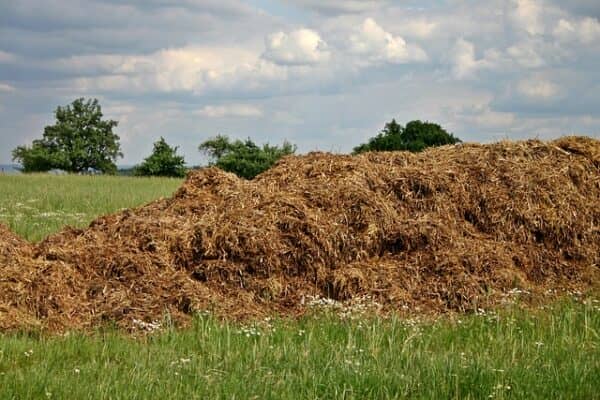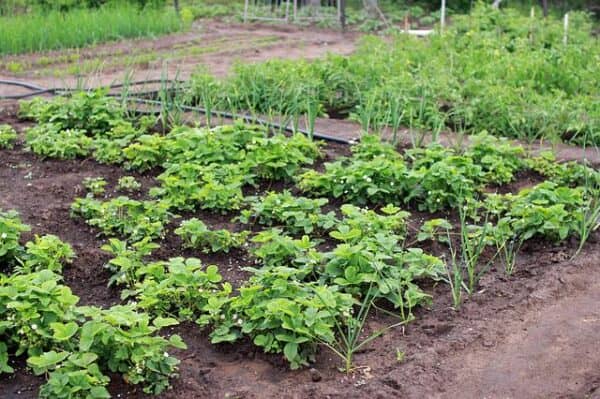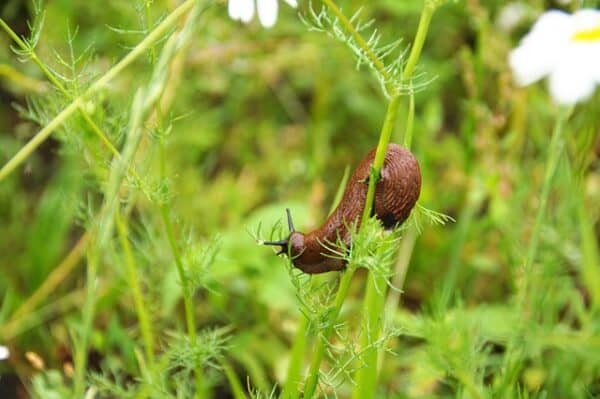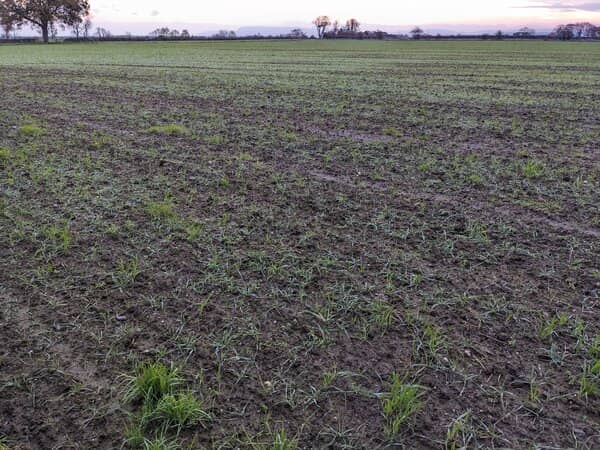Adding fertiliser to potatoes is an important step in the process of growing a great crop. However, there are many questions about the best type of potato fertiliser to use and how much is required. This article looks at using chemical and organic fertilisers and how much you should add at different stages of the plant’s growth.
How much chemical fertiliser should be added to potato plants?
The amount of fertiliser you should add to your potato plants depends on several factors, including the type of soil, the age of the plants, and the specific fertiliser you are using. However, as a general guideline, you can follow these recommendations:
Test your soil: Before adding any fertiliser, it’s important to test your soil to determine its nutrient content. You can buy a soil testing kit or send a sample to a lab for analysis.
Before planting: Work in a slow-release, balanced fertiliser such as a 10-10-10 at a rate of 2 to 3 pounds per 100 square feet of soil.
During growth: After the plants have emerged, side-dress them with a nitrogen-rich fertiliser such as ammonium nitrate or urea. Apply the fertiliser at a rate of 1 to 2 pounds per 100 square feet of soil. Do this when the plants are about 6 inches tall and again when they are about 12 inches tall 4-6 weeks after planting.
As the plants mature: When the plants are close to maturity and the tubers are forming, you can apply a low-nitrogen, high-phosphorus, and high-potassium fertilizer such as a 5-10-10 or a 10-20-20. Apply this fertilizer at a rate of 1 to 2 pounds per 100 square feet of soil or at a rate of about 1/2 cup per 10 feet of row.
Monitor the plants: Watch your potato plants carefully for signs of nutrient deficiency, such as yellowing leaves or stunted growth. If you notice these signs, you may need to apply additional fertiliser.
It’s important not to over-fertilise your potato plants, as this can lead to excessive foliage growth at the expense of tuber development. Always follow the instructions on the fertiliser package and adjust the amount based on your specific growing conditions.
How much organic fertiliser should be added to potato plants?
The amount of organic fertiliser to use for growing potatoes also depends on the same factors as chemical fertiliser, such as the quality of your soil, the type of organic fertilizer you are using, the variety of potatoes and the size of your potato garden.
Test your soil and work out the nutrient needs of the potato variety first. The amount of fertiliser each potato variety requires can be found online in the UK fertiliser manual.
There are many types of organic fertilisers, such as compost, aged manure, fish emulsion, and bone meal. Choose a fertiliser that is high in nitrogen for early growth, such as blood meal, and one that is high in potassium for later growth, such as kelp meal or wood ash.
Apply fertiliser before planting: To give your potato plants a good start, mix in a slow-release organic fertilizer such as well-rotted farmyard manure or compost into the soil before planting. A general rule of thumb is to apply about 1 wheelbarrow of well-rotted organic fertilizer such as farmyard manure or compost per 100 square feet of soil.
Apply additional fertiliser during the growing season: As your potato plants grow, they will need additional nutrients to produce healthy foliage and tubers. About 4-6 weeks after planting, you can apply a side-dressing of organic fertiliser, such as compost or fish emulsion, at a rate of about 1 bucket (3 gallons/15 litres) per 10 feet of row.
Remember to mix your organic fertiliser well into the soil, both at planting and when applying top dressings. Top dressings should not be applied thicker than 1″ onto the soil and should be then worked in. Be careful not to unearth the potatoes near the surface of the soil.
Usually, organic fertilisers are not as potent as chemical fertilisers, so you may need slightly more to get the same results. I have listed a few organic fertilisers you can use below:
Blood meal
Blood meal is a dry, high-nitrogen fertiliser made from animal blood. Here is the nutrient breakdown of blood meal:
- Nitrogen (N): 12-2-0 (nitrogen-phosphorus-potassium) or higher.
- Phosphorus (P): 2% or lower.
- Potassium (K): 0% or lower.
- Other nutrients: Blood meal may also contain small amounts of other nutrients, such as calcium, magnesium, sulphur, and iron.
Blood meal is primarily used as a source of nitrogen for plants, especially those that require high levels of nitrogen during their early growth stages. It is a fast-acting fertilizer that is quickly absorbed by plants and can promote rapid, vigorous growth. However, because of its high nitrogen content, it should be used carefully and not over-applied, as this can lead to nutrient imbalances and harm the plants.
Farmyard manure
The nutrient breakdown of farmyard manure can vary depending on the type of animal and feed used, the age of the manure, and other factors. However, in general, farmyard manure is a rich source of organic matter and contains a range of nutrients that can benefit plant growth. Here is a typical nutrient breakdown for fresh farmyard manure:

- Nitrogen (N): 0.5-1.5%
- Phosphorus (P): 0.2-0.5%
- Potassium (K): 0.5-1.5%
- Other nutrients: Farmyard manure also contains a range of other essential plant nutrients, such as calcium, magnesium, sulphur, and trace elements like iron, zinc, and manganese.
Compost
The nutrient breakdown of compost can vary depending on the type of materials used to make it, the composting method, and the age of the compost. However, in general, compost is a rich source of organic matter and contains a range of nutrients that can benefit plant growth. Here is a typical nutrient breakdown for compost:
- Nitrogen (N): 1-3%
- Phosphorus (P): 0.5-2%
- Potassium (K): 1-4%
- Other nutrients: Compost also contains a range of other essential plant nutrients, such as calcium, magnesium, sulfur, and trace elements like iron, zinc, and manganese.
Compost is a slow-release fertiliser, which means that the nutrients are gradually released over time as the compost breaks down further in the soil. In addition to its nutrient content, compost can also improve soil structure, water-holding capacity, and microbial activity. It can also help to suppress soil-borne diseases and pests.
Because compost is made from organic materials, it is a sustainable and environmentally friendly fertiliser option. It’s also easy to make your own compost at home from kitchen scraps, yard waste, and other organic materials. The nutrient content of homemade compost can vary depending on the materials used, but it’s generally a rich source of nutrients for plants.
Fish emulsion
Fish emulsion is a liquid organic fertilizer made from fish byproducts, such as heads, bones, and other unused parts of the fish. Here is the typical nutrient breakdown of fish emulsion:
- Nitrogen (N): 5-5-2 (nitrogen-phosphorus-potassium) or higher
- Phosphorus (P): 1-3%
- Potassium (K): 1-3%
- Other nutrients: Fish emulsion also contains trace elements and micronutrients, such as iron, zinc, and manganese, as well as small amounts of calcium and magnesium.
Fish emulsion is a fast-acting fertiliser that is quickly absorbed by plants and can promote rapid growth and green foliage. It’s particularly useful for plants that require high levels of nitrogen, such as leafy vegetables, grasses, and other fast-growing plants. However, because it’s a concentrated fertiliser, it should be used carefully and not over-applied, as this can lead to nutrient imbalances and harm the plants.
Fish emulsion is also a sustainable and environmentally friendly fertiliser option, as it is made from waste products that would otherwise be discarded. It can be used on a range of plants, including vegetables, fruits, flowers, and lawns.
Comparing the potency of chemical and organic fertiliser
For example: In 100kg of farmyard manure, you will have roughly 1kg of Nitrogen, 0.3kg of Phosphorus and 1kg of Potassium – compare that to a 50kg bag of 10-10-10 chemical fertiliser which will have 10% of the weight of the bag in N, P and K which is 5kg Nitrogen 5kg Phosphorous and 5kg of Potassium.
In addition to its nutrient content, farmyard manure can also improve soil structure, water-holding capacity, and microbial activity. However, because of its variability in nutrient content, it’s a good idea to have your manure tested for nutrient content before applying it to your garden. You can also use composted manure, which has been broken down over time and is more stable in nutrient content.
Is it better to use chemical or organic fertilizer to grow potatoes?
Both chemical and organic fertilisers can be used to grow potatoes, but there are some differences between the two.
Chemical fertilizers are synthetic fertilisers that are made from inorganic chemicals. They typically contain a high concentration of nutrients, such as nitrogen, phosphorus, and potassium, in forms that are quickly and easily absorbed by plants. Chemical fertilisers can be very effective at promoting fast growth and high yields, but they can also be expensive and can have negative impacts on the environment if overused or applied incorrectly.
Organic fertilisers, on the other hand, are made from natural materials such as animal manure, compost, and bone meal. They tend to release nutrients more slowly than chemical fertilisers, which can be beneficial for soil health and can help to prevent nutrient runoff and pollution.
Organic fertilisers can also improve soil structure, water retention, and microbial activity. However, they can be more expensive than chemical fertilisers and may require more time and effort to apply.
When deciding between chemical and organic fertilizers for potatoes, it’s important to consider your goals, budget, and environmental concerns. If you’re looking for a quick boost of nutrients and are willing to invest in synthetic fertilisers, these may be a good option for you. If you’re more concerned about long-term soil health and sustainability, organic fertilisers may be a better choice.



